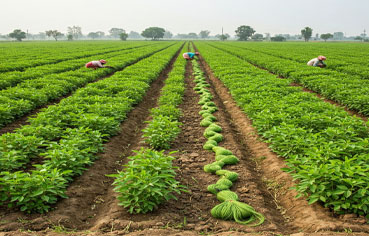About Jute
- Home
- About Jute
About Jute


Jute is a natural fibre known for its strength and versatility, making it an excellent material for various products, including bags. It is biodegradable and environmentally friendly, contributing to sustainability efforts. Jute bags are not only durable but also stylish, making them a popular choice for eco-conscious consumers.
Where do we get Jute?
Jute in India is primarily sourced from the eastern states, with West Bengal being the largest producer. Other significant jute-producing states include Assam, Bihar, Odisha, and Tripura. The favourable climate and fertile soil in these regions contribute to the cultivation of jute, making India one of the leading producers of this natural fibre in the world.
How jute is produced?
Jute is a natural fibre that is primarily produced from the jute plant, which is cultivated in warm, humid climates. The production process of jute involves several key steps:
- Cultivation: Jute is typically sown in the months of March to April and harvested in July to August. The plants thrive in well-drained, fertile soil and require plenty of sunlight and rainfall.
- Harvesting: Once the jute plants reach maturity, they are harvested by cutting the stems close to the ground. This is usually done when the flowers have bloomed and the seeds have formed.
- Retting: After harvesting, the jute stalks are bundled and submerged in water for a process called retting. This helps to separate the fibres from the woody parts of the plant. Retting can take several days, depending on the temperature and water conditions.
- Stripping: Once retting is complete, the jute fibres are stripped from the stalks. This is done by hand, and the fibres are then washed to remove any remaining impurities.
- Drying: The extracted fibres are spread out in the sun to dry. Proper drying is crucial to prevent Mold and ensure the fibres remain strong.
- Baling: After drying, the jute fibres are sorted, graded, and then compressed into bales for storage and transportation.
- Processing: Finally, the jute fibres can be processed into various products, including burlap, sacks, ropes, and other textiles.
Overall, jute production is a labour-intensive process that relies on traditional methods, but it plays a significant role in the economy of many countries, particularly in South Asia.
What are the products made from jute?
Jute is a versatile natural fiber that is used to create a variety of products. Some of the most common products made from jute include:
- Jute Bags: Eco-friendly shopping bags, tote bags, and promotional bags that are biodegradable and reusable.
- Jute Rugs and Carpets: Durable and stylish floor coverings that add a natural touch to home decor.
- Jute Twine and Rope: Strong and sturdy twine used for gardening, crafting, and packaging.
- Jute Sacks: Used for packaging agricultural products like grains, coffee, and potatoes.
- Jute Upholstery: Fabric used for furniture covering, providing a rustic and natural look.
- Jute Crafts: Various handmade items such as wall hangings, coasters, and decorative pieces.
- Jute Geotextiles: Used in civil engineering for soil erosion control and landscaping.
- Jute Paper: Eco-friendly paper products made from jute fibers, used for wrapping and crafts.
These products highlight the sustainability and utility of jute, making it a popular choice in various industries.




